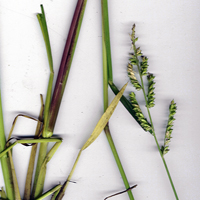Junglerice (Echinochloa colona L.) seedling emergence model as a tool to optimize pre-emergent herbicide application

Accepted: 15 June 2021
HTML: 18
All claims expressed in this article are solely those of the authors and do not necessarily represent those of their affiliated organizations, or those of the publisher, the editors and the reviewers. Any product that may be evaluated in this article or claim that may be made by its manufacturer is not guaranteed or endorsed by the publisher.
Junglerice (Echinochloa colona), one of the worst and most problematic weeds globally, causes significant economic losses due to yield loss and control cost increase. Taking into account that this weed emerges in approximately five months - from September to January -, and considering that reducing herbicide use is key in the current intensification of agricultural production systems, the present study was carried out under the hypothesis that there should be an optimal moment for pre-emergent herbicide application to achieve maximum weed control effectiveness and efficiency. Therefore, experiments were carried out from August 2016 to January 2021 in Pergamino, Buenos Aires province, Argentina, using a double-logistic emergence model of junglerice seedlings. Bicyclopyrone plus s-metolachlor, clomazone, and pyroxasulfone plus saflufenacil were applied at different times between 92 and 478 growing degree days (GDDs). Single applications between 348 and 399 GDD were observed to reduce junglerice seedling emergence by 85-99%, depending on the herbicide used. Such a seedling emergence reduction could be a convenient strategy to provide significant weed suppression in the field in combination with a competitive crop and within a sustainable production system. The results of the present study lead to the conclusion that using predictive models for pre-emergent herbicide applications ensures more effective use of herbicides and reduces the amounts of herbicides used and the risks of selecting herbicide-resistant junglerice populations.
Highlights
- Weed occurrence indirectly increases the number of herbicide applications in Argentina.
- Reducing the number and volume of herbicide applications contributes to mitigating environmental impact in the short term.
- There is a critical time during weed emergence in which chemical control via herbicide application is most effective.
- Seedling emergence models are useful management tools to predict critical timing for weed control.
How to Cite

This work is licensed under a Creative Commons Attribution-NonCommercial 4.0 International License.
PAGEPress has chosen to apply the Creative Commons Attribution NonCommercial 4.0 International License (CC BY-NC 4.0) to all manuscripts to be published.

 https://doi.org/10.4081/ija.2021.1845
https://doi.org/10.4081/ija.2021.1845



